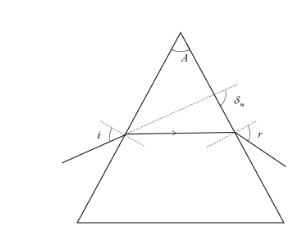
For the angle of minimum deviation of a prism to be equal to its refracting angle, the prism must be made of a material whose refractive index:
\[A)\] Lies between \[\sqrt{2}\] and \[1\].
\[B)\] Lies between \[2\] and \[\sqrt{2}\].
\[C)\] Is less than \[2\].
\[D)\] Is greater than \[2\].
Answer
576.6k+ views
Hint: Firstly we need to draw a diagram to understand the situation clearly. We will use the equation to find the refractive index of a prism and substitute the given situation of angle of minimum deviation in the expression and hence obtain an equation for the refractive index. Then we will apply the limit from \[0{}^\circ \] to \[90{}^\circ \] and obtain the range of refractive index which we could have using the given angle of minimum deviation.
Formula used:
\[\mu =\dfrac{\sin \dfrac{\left( A+{{\delta }_{m}} \right)}{2}}{\sin \dfrac{A}{2}}\]
Complete step by step answer:
We will draw the diagram using the parameters, angle of prism as (\[A\]), angle of incidence (\[i\]), angle of refraction (\[r\]) and angle of minimum deviation (\[{{\delta }_{m}}\]).

It is given that angle of minimum deviation to be equal to the refracting angle.
\[\Rightarrow {{\delta }_{m}}=A\]
Now, we will substitute this in the equation to find the refractive index of prism and it will become,
\[\mu =\dfrac{\sin \dfrac{\left( A+A \right)}{2}}{\sin \dfrac{A}{2}}=\dfrac{\sin \left( A \right)}{\sin \dfrac{A}{2}}\]
Now, we will use the trigonometric relation \[\sin \left( x \right)=2\sin \left( \dfrac{x}{2} \right)\cos \left( \dfrac{x}{2} \right)\].
\[\Rightarrow \mu =\dfrac{\sin \left( A \right)}{\sin \dfrac{A}{2}}=\dfrac{2\sin \left( \dfrac{A}{2} \right)\cos \left( \dfrac{A}{2} \right)}{\sin \left( \dfrac{A}{2} \right)}\]
\[\mu =2\cos \left( \dfrac{A}{2} \right)\]
So, we have the expression for a refractive index.
Now we will apply the limit for angle of prism from \[0{}^\circ \] to \[90{}^\circ \]. Then, if \[A\] is \[0{}^\circ \],
\[\mu =2\cos \left( \dfrac{0}{2} \right)=2\]
And if \[A\] is \[90{}^\circ \], \[\mu =2\cos \left( \dfrac{90}{2} \right)= 2\cos \left( 45 \right)=\sqrt{2}\]
So, we can conclude that the prism could have a refractive index which lies between \[2\] and \[\sqrt{2}\].
So, the correct answer is “Option B”.
Note:
The soul of this question is situated at the part where we are applying the limit for \[A\].
There we are taking the angles \[0{}^\circ \] to \[90{}^\circ \] because they are the maximum and minimum angles which a prism could have. We are taking \[{{\delta }_{m}}=A\] because if the minimum deviation is equal to refracting angle, by geometry, the angle of prism and the refracting angles will be equal.
Formula used:
\[\mu =\dfrac{\sin \dfrac{\left( A+{{\delta }_{m}} \right)}{2}}{\sin \dfrac{A}{2}}\]
Complete step by step answer:
We will draw the diagram using the parameters, angle of prism as (\[A\]), angle of incidence (\[i\]), angle of refraction (\[r\]) and angle of minimum deviation (\[{{\delta }_{m}}\]).

It is given that angle of minimum deviation to be equal to the refracting angle.
\[\Rightarrow {{\delta }_{m}}=A\]
Now, we will substitute this in the equation to find the refractive index of prism and it will become,
\[\mu =\dfrac{\sin \dfrac{\left( A+A \right)}{2}}{\sin \dfrac{A}{2}}=\dfrac{\sin \left( A \right)}{\sin \dfrac{A}{2}}\]
Now, we will use the trigonometric relation \[\sin \left( x \right)=2\sin \left( \dfrac{x}{2} \right)\cos \left( \dfrac{x}{2} \right)\].
\[\Rightarrow \mu =\dfrac{\sin \left( A \right)}{\sin \dfrac{A}{2}}=\dfrac{2\sin \left( \dfrac{A}{2} \right)\cos \left( \dfrac{A}{2} \right)}{\sin \left( \dfrac{A}{2} \right)}\]
\[\mu =2\cos \left( \dfrac{A}{2} \right)\]
So, we have the expression for a refractive index.
Now we will apply the limit for angle of prism from \[0{}^\circ \] to \[90{}^\circ \]. Then, if \[A\] is \[0{}^\circ \],
\[\mu =2\cos \left( \dfrac{0}{2} \right)=2\]
And if \[A\] is \[90{}^\circ \], \[\mu =2\cos \left( \dfrac{90}{2} \right)= 2\cos \left( 45 \right)=\sqrt{2}\]
So, we can conclude that the prism could have a refractive index which lies between \[2\] and \[\sqrt{2}\].
So, the correct answer is “Option B”.
Note:
The soul of this question is situated at the part where we are applying the limit for \[A\].
There we are taking the angles \[0{}^\circ \] to \[90{}^\circ \] because they are the maximum and minimum angles which a prism could have. We are taking \[{{\delta }_{m}}=A\] because if the minimum deviation is equal to refracting angle, by geometry, the angle of prism and the refracting angles will be equal.
Recently Updated Pages
A man running at a speed 5 ms is viewed in the side class 12 physics CBSE

The number of solutions in x in 02pi for which sqrt class 12 maths CBSE

State and explain Hardy Weinbergs Principle class 12 biology CBSE

Write any two methods of preparation of phenol Give class 12 chemistry CBSE

Which of the following statements is wrong a Amnion class 12 biology CBSE

Differentiate between action potential and resting class 12 biology CBSE

Trending doubts
What are the major means of transport Explain each class 12 social science CBSE

Draw ray diagrams each showing i myopic eye and ii class 12 physics CBSE

Draw a ray diagram of compound microscope when the class 12 physics CBSE

Give simple chemical tests to distinguish between the class 12 chemistry CBSE

Using Huygens wave theory derive Snells law of ref class 12 physics CBSE

Dihybrid cross is made between RRYY yellow round seed class 12 biology CBSE




